Artists across another terrain: Non-Kiwi interpretations of Kiwi poetry
Overseas representations of New Zealand poetry
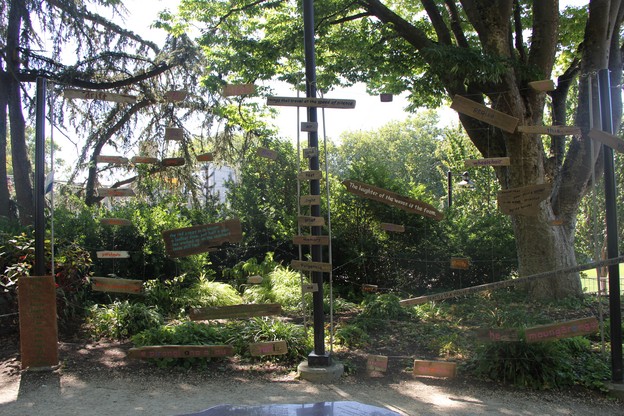
Kia ora ano [Hello again].
As promised in the previous commentary, in these variegated tangents away from the vast soft white underbelly of New Zealand poetry, I here focus on two non–New Zealanders and their valuable and vitally different representations of Kiwi poets and their mahi, or work. One is French, one is American; both have been keenly involved in publishing or producing New Zealand poems for quite some time now. Both are visual artists. Alphabetically, I now approach them — America to France.
David Kelly-Hedrick is an artist who works with Kiwi (and others’) words and transforms them into quite brilliant tree/fence/free-range poetic sculptures.
Describe what you do in terms of depicting Kiwi poems (i.e. written by NZ poets) via your tree sculptures (that is, the physical outdoor depictions).
I gather scrap pieces of wood, often pieces that have washed up in our harbors and along our beaches, and I router words and lines of great verse and then paint them in bright acrylic colors. I place these lines in organized art installations or leave them out in public locations. I wish to lift and place poetry in surprising places. I want it to last a while, to fare all right in the weather. I want to install these wood planks and let them sing with new art. I started nearly ten years ago with an installation in a Botanical Garden in the States and have continued from there. In Dunedin, New Zealand, I collaborated with the poet Loveday Why on a Wild Lines installation as part of the Dunedin Fringe Festival.
Most recently, I had an installation called drift in the Seattle Center Poetry Garden which included a wide range of contemporary Pacific Rim poets and an especially generous selection of Kiwi poets. I have sold and given away a fair number of these poetry creations. Some I have just left out in urban, suburban, and wild locations from the desert Southwest of the US to paths along the harbor in Dunedin. One hangs in classroom in Juneau, Alaska, while another graces the wall of our local bookstore here on Mercer Island, Washington.

Southern (NZ) Man - David Kelly-Hedrick
Please tell us why you did/do this for Kiwi poetry.
I came with my family to New Zealand for a year in 2012 both for the adventure and as my wife was filling a position at the hospital with the Southern District Health Board in Dunedin. The experience was a privilege and an honor. It likely avoided a midlife crisis, as I found solace and inspiration in having my life turned a bit upside down/inside out. We did a lot of walking and driving on both islands. We celebrated my fiftieth birthday at Sandfly beach on the Otago Peninsula with wine and a picnic, and while it was summer in December, the day was nearly as chilly as winter here in Seattle. We made some dear friends and wonderful acquaintances.
Not finding paid work in NZ for myself, I performed a bunch of father duties and did some volunteer work with a couple of organizations such as the Yellow-Eyed Penguin Trust. I also lent a hand with some of the wonderful creative efforts that Ruth Arnison does with Poetry in the Waiting Room [Excellent work Ruth, I agree — Rapatahana]. The year enriched each of our family members in wide and various ways. I had a reprieve from my career in youth development work. Always being a writer and an artist as an avocation, I spent considerable time reading, writing, messing about, and wandering. I recall stumbling upon a Hone Tuwhare volume in the Dunedin library and that positively rattled my senses and set me off seeking more Aotorea and South Pacific poets.
I find myself thinking quite frequently about where and how words, phrases, and lines of verse come to us. Lately, it strikes me that poetry coalesces at the intersection of atmosphere, landscape, and person (in particular, a poet who is attuned to receiving these bursts of word gifts). If this be so, why then, New Zealand may be one of those unique places in the world where this poetry creation explodes with a special frequency and power. Perhaps this is related to gusty southern winds and tides. Or to the exposed hillocks and laundry flapping on front porches. I am certain that NZ poets know these sources much better than I, and also that there is a deep lineage of artists and writers on the islands.
Is there a particular type of Kiwi poem which you prefer to depict?
I believe I seek poets that startle readers in accessible and fresh ways. Like most readers, I am pretty particular in my tastes, though I cannot so easily define specific appeals. I love questions in poems and ways that poets are wondering about being here and being part of their landscapes. I like open-ended, profound statements and clear visions of the particular. There are so many amazing NZ poets that I keep discovering (frequently thanks to Vaughan’s profiles and essays of his fellow poets there) such as Courtney Sina Meredith, Kiri Piahana, and Mariana Isara. It felt right and electric to place their powerful lines adjacent to contemporary verse from Japan, China, and the Pacific Northwest of the US for the drift installation. 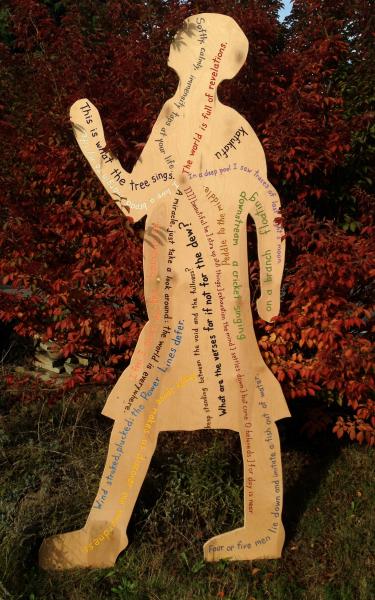
I asked David for links to his fine work, as shown above.
I wish I were more organized to post, publish, and submit my works, but despite several efforts to begin and maintain Wordpress blogs and regularly submit poems to journals, I kind of fail on the self-promotion front due jointly to laziness, my job as a middle-school English teacher, and the fact that I am so wowed by other poets. Some of work is scattered out there. More is lying about my garage and on shelves in our house. I intend to complete a manuscript this summer — that is probably more Zuihitsu than probably anything else — and will hopefully shop it around to some publishers. [Here is a link to drift — Rapatahana]
2013 saw David’s Wild Lines project in Dunedin fulfilled — an example, as below, in two languages too —

no sunbeams on this exhausted day
kāore ngā hihi ki he ra tino hūhē (Vaughan Rapatahana)
Manuel van Thienen is a master craftsman poet, translator, carver, painter, and artisan, who has a determined commitment to both Native American and Māori poetry and translations of this into French, via the excellent publications he produces. I asked him several questions pertaining to his interest in Kiwi qua Māori poetry.
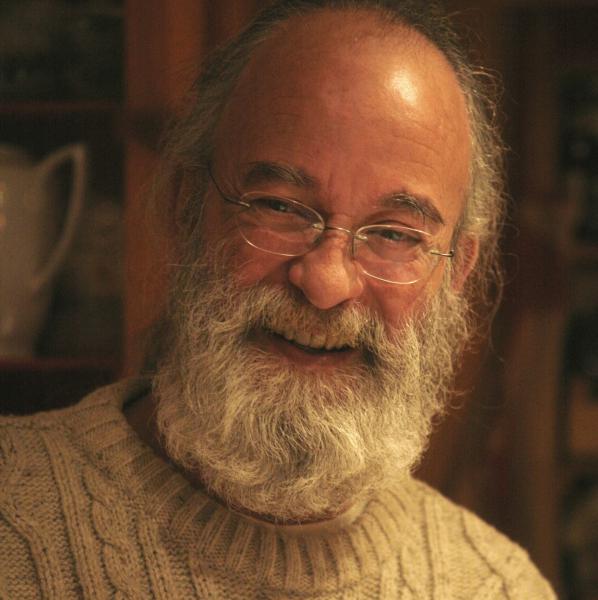
Manuel, the master craftsman
I initially established the wide gamut of work/mahi Manuel accomplishes.
I am a French poet, translator, carver, ceramist, and painter. I was born in 1953 from Normandy and Flanders (Belgium), Galician and Asturian (Spanish) ancestors (what made me a true Frenchman) and live in Ardèche (southeast of France), by my mountain le Sardier and my river le Doux in a little village named Lafarre. I am now retired, but worked previously as a primary school teacher.
So, as a poet I write poems and translate Native American, Māori, and other indigenous poets from English (Cheyenne, Māori, or other, with the help of the authors themselves) into French. I founded Sur le Dos de la Tortue, a quarterly review dedicated for more than ten years to Native American contemporary poetry, recently transformed into a publishing house Les Éditions de la Tortue. I am a director of the ‘Maison de la Poésie Rhône-Alpes,’ a poets association which publishes a review, Bacchanales.
As a woodcarver, my inspiration is mainly the goddess: “notable lack of war pictures and of male domination; the art centred on the goddess reveals a balanced social system, neither patriarchal nor matriarchal” (Marija Gimbutas in ‘Le langage de la Déesse’). I carve wood because it’s a living material. I find wood around my home. When my neighbours have to cut trees, they call me by phone to give them to me, as they think this one would do for carving. When I carve wood, I am inside the wood, I am the wood. Even if I draw a lot before I begin a sculpture, when I start to carve, I forget the drawing. Carving is a way of living deeply inside myself and the material. What more should I say …My greatest pleasure is when someone falls in love with one of my sculptures.
As a ceramist, I like to work with fire (raku or pottery) and how it transfigures clay and glaze. As a painter (I also do ‘collages’), I work on the themes of ‘war’ and ‘immigration’ to counterbalance the overwhelming amount of pictures used by the media to achieve general indifference. At least, I hope so. Now and then, I write poems on the canvas.
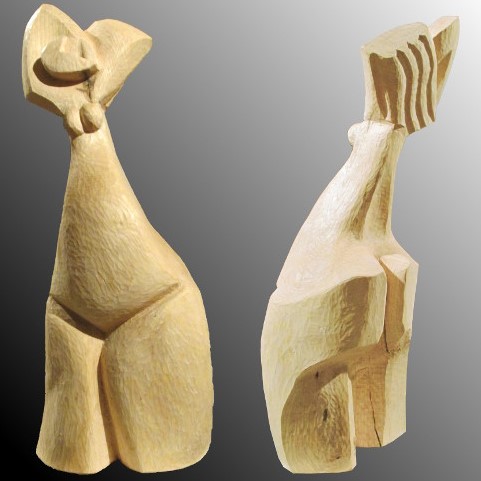
baigneuse frene
Describe what you do in terms of depicting Kiwi poems (i.e. written by NZ poets) via your translations. In other words, why do you work with Māori and Native American poets?
I always considered Gabriel Celaya was right about poetry in his poem: La poesía es un arma cargada de futuro. In other words — Poetry is a gun charged for the future.
Words are supposed to highlight what really matters for everyone as human beings: Earth’s health, our history, the wisdom of our ancestors, the meaning of the sacred, the experiences and struggles we share, our condition and hopes. Poetry has no borders. Even if the context differs, poetry remains poetry. You can’t establish a ranking between cultures; all are different and all these differences are part of the whole of humanity.
As a poet myself, I read a lot of poets and poems (as well as a lot of other books written by historians, anthropologists, politic analysts, etc.) and very often I consider it a pity I could not share them with people who can’t read them, only because they don’t understand the foreign language.
As a member of two poetry associations here in France, about thirty years ago, I discovered the works of Native American poets — as voices which no one was never able to silence. And at the same time, the shame of the colonialism — past, present, and still going on. And by the way, the similarity of the message carried on by indigenous poetry worldwide. I still feel my distaste for the English Crown and its ‘Commonwealth’ growing stronger and stronger.
I was particularly appalled by the general misunderstanding about Māori reality. When you search on the Internet, the government websites present a fairytale image: the Māori language is one of the three official language of NZ, so you would consider there are no integration issues. But when you consider social statistics, you discover it’s always the same colonialist thing: they have no real representatives, they have never recovered their stolen lands, they lived in the local kind of reservations or in the dirty big cities’ suburbs, they face poverty, unemployment, homelessness, imprisonment, sicknesses at a higher rate than other citizens.
Therefore, as a translator and a publisher, I owe indigenous poets faithful translations of their works and to introduce them and their realities to the largest audience we can reach in French-speaking countries by publishing them in reviews and in books and by organising meetings and readings. How to be the drum and the drummer — this is what I am.
Where are these works available?
As there are a lot of Māori poets, I decided to dedicate them in an anthology (the same way I did about Native American Poets). This anthology AOTEAROA — une anthologie de la poésie Māori contemporaine, presenting seventy poets, will be published in a few months, by les ‘Éditions de la Tortue’. (Aiming a larger circulation, we tried first to submit the entire project to another French poetry publisher (Le temps des Cerises) but a month before the programmed launch, the publication was indefinitely delayed, due to economic issues; we tried then to achieve a multi-publishers gathering, but failed again. So, the ‘Turtle’ will take up the challenge and make its own way, as usual.)
I met these Māori poets in several ‘local’ anthologies or reviews: Into the World of Light (1982), edited by Witi Ihimaera and D. S. Long (New Zealand: Heinemann); Mauri Ola Contemporary Polynesian Poems in English (2010) and Whetu Moana An Anthology of Polynesian Poetry (2003), both edited by Albert Wendt, Reina Whaitiri, and Robert Sullivan (Auckland University Press, New Zealand; Ora Nui Māori Literary Journal, edited by Anton Blank (New Zealand, 2012); Puna Wai Kōrero: An Anthology of Māori poetry in English, edited by Reina Whaitiri and Robert Sullivan (New Zealand: Auckland University Press, 2014); Ora Nui Special Edition, A collection of Māori and Aboriginal Literature, edited by Anton Blank and Kerry Reed-Gilbert (New Zealand and Australia, 2015).
The translations into French were made by myself and my wife Sonia Protti (who is a professional translator and has indeed also helped me with these responses!). Moreover, every time one of these poets would come to France (i.e. Apirana Taylor in 2017 and Vaughan Rapatahana in 2018), we (Éditions de la Tortue) would publish a book of his/her poems and organise a few readings/meetings. We have very little money (the reward for strict independence), but if we don’t do the work, no one else will. We are also the French co-organisers of the biennial European tour Words from the Edge, an initiative founded by the Tsistsistas/Cheyenne poet Lance Henson in 2000, who invites indigenous poets for a mini tour in five European countries: Italy, France, Germany, Austria, Switzerland.

deessequimarche
Is there a particular type of Kiwi poem/poet which you prefer to depict? I realise ngā kaituhi Māori (writers), but are there specific poetic attributes that you are looking for here?
Actually, it depends on the publishing opportunities: some publishers prefer very short texts, or about a specific theme. In absolute terms, I translate only living poets. As for myself, as their works talk about their culture, it’s fine enough, even if I prefer by far bold statements and political commitments or mythological references. But there is also the ‘feeling’ of kinship (very difficult to define) which makes the translation work easier by far.
Manuel also writes poetry. Un exemple —
blue dragonfly for Lance Henson
It comes swirling above the water hole. It hums and its look is a thousand springs. Its wings are the splinters of the mirror living in the sky. Its stoke of light radiates in the deepest part of our being.
libellule bleue pour Lance Henson
Elle vient tournoyer au-dessus de la mare. Elle vrombit et son regard est mille sources. Ses ailes sont les éclats du miroir qui habite le ciel. Sa caresse de lumière irradie au plus profond de notre être.
[Lance Henson is Tsistsistas/Cheyenne. In the Tsistsistas culture, the blue dragonfly ‘tewawitus’ is a bird-like moth and other flying insects.]
Aotearoa New Zealand poetry, then, extends well away from its salty shores and, more encouragingly, well away from an ongoing series of stark, English-language printed pages — indeed, translation into a wide range of other tongues has been ongoing for decades. What is especially appealing for me — and I am sure for others, who have been represented by both Manuel and David — is the fact that our work has been so creatively and ‘non-mainstreamly’ presented. Merci beaucoup. Again, New Zealand poetry is so wide-ranging.
I, for one, am very honoured and humbled by such overseas expressions of interest in, and reproductions of, some of my own work, as below. Vive la difference!!!
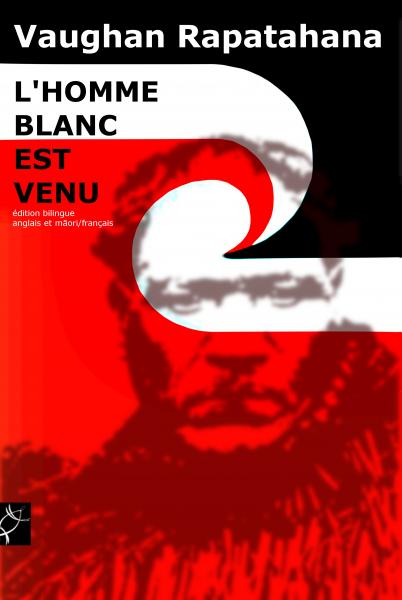
Feasting in the Skinny Country: Aotearoa New Zealand Poetry